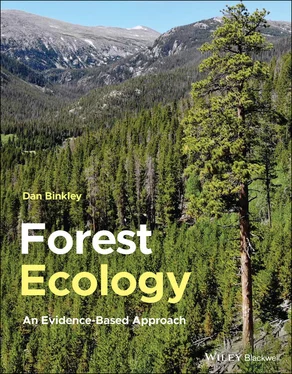Dan Binkley - Forest Ecology
Здесь есть возможность читать онлайн «Dan Binkley - Forest Ecology» — ознакомительный отрывок электронной книги совершенно бесплатно, а после прочтения отрывка купить полную версию. В некоторых случаях можно слушать аудио, скачать через торрент в формате fb2 и присутствует краткое содержание. Жанр: unrecognised, на английском языке. Описание произведения, (предисловие) а так же отзывы посетителей доступны на портале библиотеки ЛибКат.
- Название:Forest Ecology
- Автор:
- Жанр:
- Год:неизвестен
- ISBN:нет данных
- Рейтинг книги:5 / 5. Голосов: 1
-
Избранное:Добавить в избранное
- Отзывы:
-
Ваша оценка:
- 100
- 1
- 2
- 3
- 4
- 5
Forest Ecology: краткое содержание, описание и аннотация
Предлагаем к чтению аннотацию, описание, краткое содержание или предисловие (зависит от того, что написал сам автор книги «Forest Ecology»). Если вы не нашли необходимую информацию о книге — напишите в комментариях, мы постараемся отыскать её.
Forest Ecology
An Evidence-Based Approach Forest Ecology: An Evidence-Based Approach
Forest Ecology: An Evidence-Based Approach
Forest Ecology — читать онлайн ознакомительный отрывок
Ниже представлен текст книги, разбитый по страницам. Система сохранения места последней прочитанной страницы, позволяет с удобством читать онлайн бесплатно книгу «Forest Ecology», без необходимости каждый раз заново искать на чём Вы остановились. Поставьте закладку, и сможете в любой момент перейти на страницу, на которой закончили чтение.
Интервал:
Закладка:
The future development of a tree, and of a forest, derives from the gradual accumulation of routine changes, such as annual increases in height and mass of stems. Over limited periods, these gradual, expected trends are punctuated by contingent events that are largely unpredictable, such as hurricanes and invasions by exotic pathogens. Humans are another force for change in forests, through direct management (typically favoring some species over others, often limiting the opportunity for old trees to develop) and indirect activities (such as nutrient enrichment of rain, air pollution, and climate change).
Given all these forces of change, how can we predict future forests? The short answer is simply that we cannot predict future forests with much confidence. The longer (and more useful) answer is that we can indeed develop insights about the likely forests of the future, if we understand some of the basic features that have shaped forests in the past, and how ecological interactions will combine to shape future forest.
Ecological Afterthoughts: Is a Forest an Organism?
A variety of traits and processes characterize all organisms: they process high‐energy sources from the environment (such as sunlight or organic compounds) into low‐energy byproducts (such as heat), and they grow, reproduce, and die. Forests do these same things. So are forests like organisms? We have a strong tendency for using analogies to make sense of the world, and sometimes we go beyond analogies to use metaphors, where one is not simply like another, but is essentially the same. Ideas about forests have arisen commonly from analogies, and sometimes even from metaphors. For example, an influential ecologist asserted a forests‐are‐organisms metaphor a century ago:
The unit of vegetation, the climax formation, is an organic entity. As an organism, the formation arises, grows, matures and dies… The life‐history of a formation is a complex but definite process, comparable in its chief features with the life‐history of an individual plant… Succession is the process of reproduction of a formation, and this reproductive process can no more fail to terminate in the adult form than it can in the case of the individual.
(Clements 1916)
Our ideas about forests can shape what we can see in forests, and the belief in the organism‐nature of ecosystems led this ecologist to strong confidence in untested ideas, simply because he was seduced by the beauty of the organism metaphor:
It can still be confidently affirmed that stabilization is the universal tendency of all vegetation under the ruling climate, and that climaxes are characterized by a high degree of stability when reckoned in thousands or even millions of years.
(Clements 1936)
A metaphor that was true might be very useful, but a poor metaphor may be useless or even harmful. An untested metaphor could be a good starting point for science, but could not be a reliable conclusion. If forests were the same as organisms, the future composition, structure and function of forests would be largely predictable. Any deviations in that progression would risk the continued persistence of the forest. If forests are quite unlike organisms, such a belief would befuddle our ability to see the forest and the trees.
The “ecological afterthoughts” in later chapters are open‐ended invitations to apply ideas from the chapters to specific situations. The afterthoughts are not intended to convey information or answers, but just to raise questions. This first chapter goes a bit further, highlighting how the afterthoughts might be used for insights.
A listing of similarities and differences would immediately show this metaphor of “Forests are Organisms” would be weak at best, and maybe harmful if taken too seriously. Forests clearly differ from organisms in fundamental ways ( Figure 1.9). A tulip poplar seed can only lead to a tulip poplar tree, with growth rates and forms that are shaped by environmental factors and the genes of the tree. A tulip poplar that deviated from normal structure and function would soon be a dead tulip poplar, with no chance to send more of its genes into future generations.
A forest that contains tulip poplar trees is much less constrained in its future development. Unlike organisms, forests routinely gain and lose genes as members of species enter and leave the forest; there is no single way for a forest to be, and no single path that must be followed if a landscape will remain dominated by trees. If we believe forests are organisms, the loss of major components should be expected to endanger the whole. The death of an organism is an event that encompasses all its parts. The “death” of a forest is always a matter of perspective; major events kill some trees, plants and animals, leading to greater opportunities for the surviving trees, plants and animals. Forests persist through the gains and losses of individuals and species; organisms generally don't persist through the gains and losses of organs (aside from seasonal senescence of leaves and fine roots). A tree that lost its leaves and never regrew a new set of leaves would die; a forest that lost all members of a given tree species (with that species never returning), would remain quite viable.
Several of the dominant species formerly found in tulip poplar forests disappeared from the landscape in recent times, including chestnut trees, passenger pigeons, wolves and mountain lions, while the human influences shifted from Cherokee to European cultures. Nevertheless, forests that contain tulip poplar trees continue to exist and change, as individual organisms and species shift in response to changing stresses and opportunities. The forests of the future will not be the same as those in the past, and change over time is a normal aspect of forests.

FIGURE 1.9 As with the tulip poplar and tulip poplar forest examined in this chapter, all trees have very limited scope in their development from seed to mature tree, and all forests have very broad scope in their composition and structure over time. This ponderosa pine tree (left) developed from a seed that contained genetic material from two parent trees. The potential future states of this plant were determined and constrained by these genes. The actual development of the tree depended on climate, weather events, fires, and interactions with a huge variety of microorganisms, animals, and other plants. No two ponderosa pine trees are identical, yet the range of differences among ponderosa pine trees is miniscule compared to the range differences in the composition of forests that contain ponderosa pine trees. Unlike the tree, the forest where this tree grew did not have a particular beginning; major events such as fires killed many trees, but many survived (including the root system of aspens that sent up a new generation of stems from ancient root stocks), as did many of the understory plants. The dynamics of the forest were not determined or constrained by the genes of a single species, and the composition of the forest shifted over the decades in response to climate, rapid events, and management. The forest continues as the death and birth of individuals subtracts and adds genetic possibilities for the future.
This flexibility in the genetic composition of forests ensures that the organism metaphor confuses rather than enlightens. Complex, changeable forests have far greater capacity for change than organisms, ensuring that the future development of forests is anything but precisely predictable.
CHAPTER 2 Forest Environments
Интервал:
Закладка:
Похожие книги на «Forest Ecology»
Представляем Вашему вниманию похожие книги на «Forest Ecology» списком для выбора. Мы отобрали схожую по названию и смыслу литературу в надежде предоставить читателям больше вариантов отыскать новые, интересные, ещё непрочитанные произведения.
Обсуждение, отзывы о книге «Forest Ecology» и просто собственные мнения читателей. Оставьте ваши комментарии, напишите, что Вы думаете о произведении, его смысле или главных героях. Укажите что конкретно понравилось, а что нет, и почему Вы так считаете.












